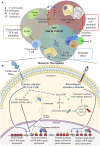Non-specific Effects of Vaccines Illustrated Through the BCG Example: From Observations to Demonstrations
- PMID: 30564249
- PMCID: PMC6288394
- DOI: 10.3389/fimmu.2018.02869
Non-specific Effects of Vaccines Illustrated Through the BCG Example: From Observations to Demonstrations
Abstract
Epidemiological studies regarding many successful vaccines suggest that vaccination may lead to a reduction in child mortality and morbidity worldwide, on a grander scale than is attributable to protection against the specific target diseases of these vaccines. These non-specific effects (NSEs) of the Bacille Calmette-Guérin (BCG) vaccine, for instance, implicate adaptive and innate immune mechanisms, with recent evidence suggesting that trained immunity might be a key instrument at play. Collectively referring to the memory-like characteristics of innate immune cells, trained immunity stems from epigenetic reprogramming that these innate immune cells undergo following exposure to a primary stimulus like BCG. The epigenetic changes subsequently regulate cytokine production and cell metabolism and in turn, epigenetic changes are regulated by these effects. Novel -omics technologies, combined with in vitro models for trained immunity and other immunological techniques, identify the biological pathways within innate cells that enable training by BCG. Future research should aim to identify biomarkers for vaccine heterologous effects, such that they can be applied to epidemiological studies. Linking biological mechanisms to the reduction in all-cause mortality observed in epidemiological studies will strengthen the evidence in favor of vaccine NSEs. The universal acceptance of these NSEs would demand a re-evaluation of current vaccination policies, such as the childhood vaccination recommendations by the World Health Organization, in order to produce the maximum impact on childhood mortality.
Keywords: BCG; epidemiology; epigenetics; non-specific effects; trained immunity; vaccines.
Figures


References
Publication types
MeSH terms
Substances
LinkOut - more resources
Full Text Sources
Medical

